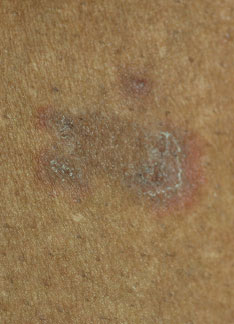Should this eruption prompt a search for other lesions?
 For a few months, a 51-year-old woman has had an asymptomatic rash on her proximal thighs. She claims to have no other rashes and denies any exposure history.
For a few months, a 51-year-old woman has had an asymptomatic rash on her proximal thighs. She claims to have no other rashes and denies any exposure history.
What are you looking at here?
A. Tinea corporis.
B. Erythema multiforme.
C. Lichen planus.
D. Erythema annulare centrifugum.
E. Nummular eczema
Bonus question: Is there any diagnostic procedure you would perform?
Double bonus question: What other part of the body would you check
and why?
(Answers on next page)
Case 1: Erythema multiforme
A skin biopsy confirmed the clinical impression of erythema multiforme, B.
Answer to bonus question: The patient was asked whether he had a history of fever blisters. Although the answer was no, about 80% of persons with herpes simplex virus infection—the most common cause of erythema multiforme—are asymptomatic carriers.1,2 This patient was given a course of daily oral antiviral therapy as a trial in an attempt to prevent the next recurrence
Contact dermatitis is possible, although the clinical pattern is not consistent with exposure to a contactant. Psoriasis would not remit and recur, and more scaling would be expected. Similarly, lichen planus would not come and go; moreover, the primary lesion is a flat polygonal papule. Dyshidrosis would feature more vesicles on the sides of the fingers as well as the palms.
References:
1. Auquier-Dunant A, Mockenhaupt M, Naldi L, et al; SCAR Study Group. Severe Cutaneous Adverse Reactions. Correlations between clinical patterns and causes of erythema multiforme majus, Stevens-Johnson syndrome, and toxic epidermal necrolysis: results of an international prospective study. Arch Dermatol. 2002;138:1019-1024.
2. Viral infections. In: Neville BW, Damm DD, Allen CM, Bouquot JE, eds. Oral and Maxillofacial Pathology. 3rd ed. Philadelphia: Elsevier Health Sciences; 2008:240-284.


